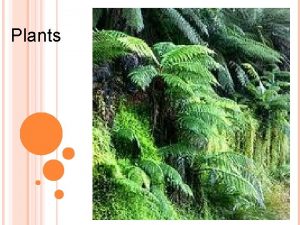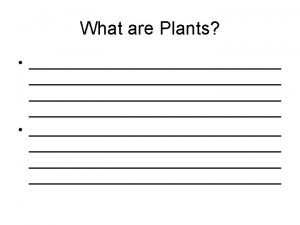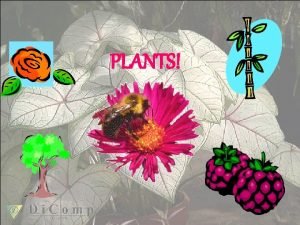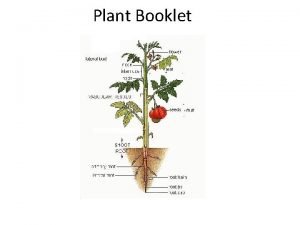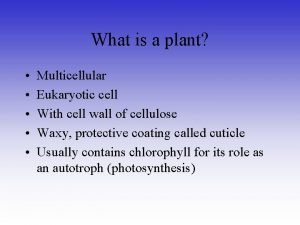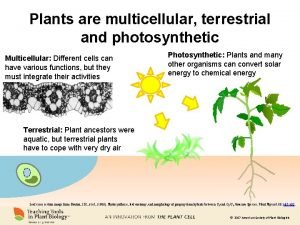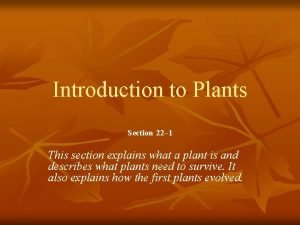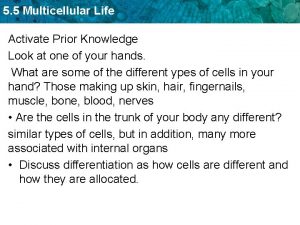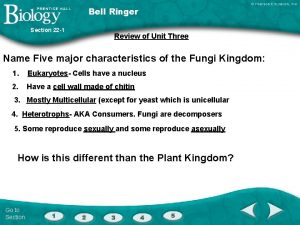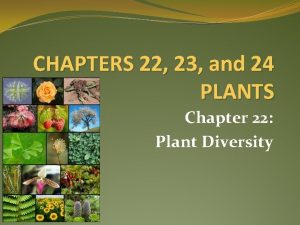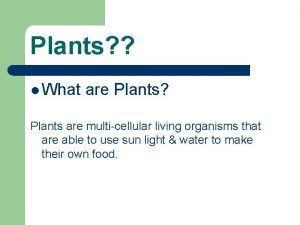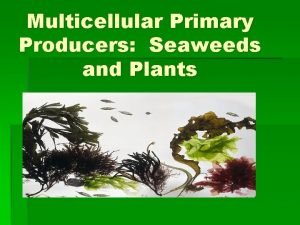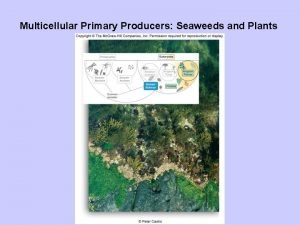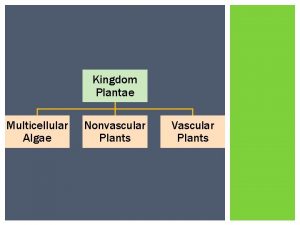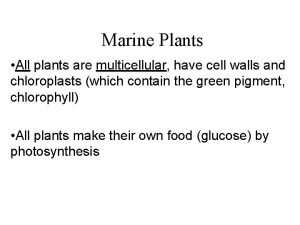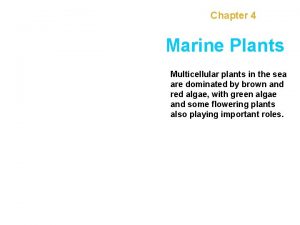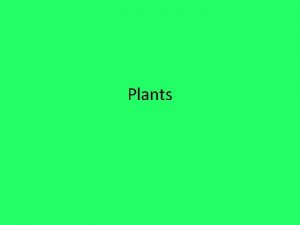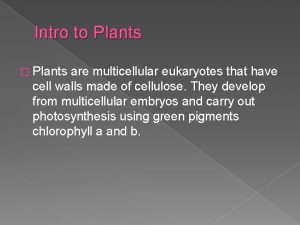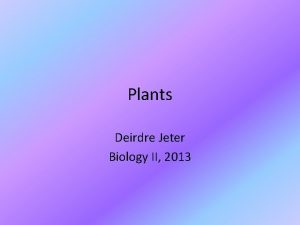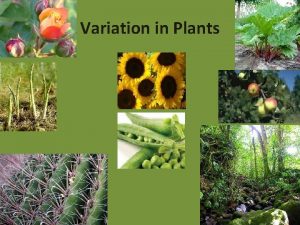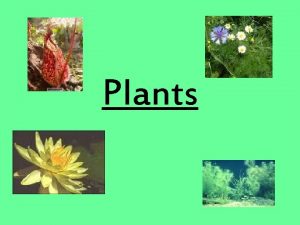Introduction to Plants Section 18 3 Multicellular Plants
















- Slides: 16

Introduction to Plants Section 18 -3: Multicellular Plants

What is a plant? § § § Multicellular, photosynthetic, eukaryotic Cell walls of cellulose Most reproduce sexually with an alternation of generations § Few can reproduce asexually

Adaptations to Life on Land § Adapted a way to prevent water loss and conduct photosynthesis (leaves) § Provide surface area to capture sunlight (broad and flat = more light) § Greater surface area, more tissue exposed to air, more water is lost by evaporation

More on Leaves § Leaves of most land plants are covered by a cuticle, which is a waxy, waterproof covering § Leaf exchanges oxygen and carbon dioxide with the air for photosynthesis and respiration through small openings called stomata (singular is stoma) § Stomata open and close as needed to allow for gas exchange and prevention of water loss

Adaptations to Life on Land § Developed rigid structures to support themselves and hold leaves to sun and position them to capture as much light as possible (stems) § Stems also house the plant’s vascular tissues

Challenges to Life on Land § Developed structures to anchor them in place and absorb water and dissolved inorganic nutrients from the soil (roots) § Developed internal transport system (vascular tissues) § Designed to move water and nutrients from the soil to the rest of the plant, and the products of photosynthesis from the leaves to the rest of the plant

More on Vascular Tissues § Xylem carries water and dissolved inorganic nutrients from roots to branches and leaves § Cellulose in the xylem is very thick/strong, contributing to the strength of woody plants and trees § Phloem carries the products of photosynthesis and other substances from one part of the plant to another § Can move substances upward or downward depending on the season, time of day, or health of the plant

Adaptations to Life on Land § Developed new way to transport sperm to egg outside of water § All plant life cycles involve alternation of generations between sporophyte and gametophyte

Seed-bearing Plants § Important evolutionary step because seeds mean that standing water is not required for reproduction § A seed is a reproductive structure that includes a developing plant and a food reserve enclosed in a resistant outer covering

Seed-bearing Plants § Seeds are resistant to drying, and can usually survive in drought conditions and periods of intense heat for several years. § Tougher and more resistant to drying than spores. § Contain a fully formed plant embryo, rather than the single cell found in spores. § Contain stored food, and many also have special structures that aid in their distribution.

Gymnosperms § § § Include plants like cycads, gingkoes, and conifers Seeds are exposed to the air, usually in a cone Most common gymnosperms are conifers (keep their leaves for 2 -14 years) whose need -like leaves are adapted for survival through cold, dark winters

Angiosperms § Flowering plants § Food sources for humans and other animals § Evolved later than the gymnosperms § Key to success is the evolution of flowers, which allow angiosperms to reproduce and grow to maturity more quickly than gymnosperms

Angiosperms § § Two groups– monocots and dicots Within the seeds of angiosperms are food reserves for the developing plant called cotyledons Monocots have one cotyledon and include things like rice, wheat, corn, tulips, orchids, lilies, and palms Dicots have two cotyledons, and include things like tomatoes, roses, maples, daisies, and sunflowers

Monocots vs Dicots

Reproduction in Seedbearing Plants § Sporophyte generation is dominant § Gametophytes are small clusters of cells that grow in the cones of gymnosperms or the flowers of angiosperms § Pollen is tiny, and represents what will grow into the male gametophyte § The egg is much larger and grows into the female gametophyte

Alternation of Generations
 Are plants multicellular
Are plants multicellular Plants are multicellular eukaryotes
Plants are multicellular eukaryotes Are plants multicellular
Are plants multicellular Plants are multicellular eukaryotes
Plants are multicellular eukaryotes Plants are multicellular eukaryotes
Plants are multicellular eukaryotes Photosynthetic, multicellular, and terrestrial?
Photosynthetic, multicellular, and terrestrial? Distinct characteristics of plantae
Distinct characteristics of plantae Are cell walls prokaryotic or eukaryotic
Are cell walls prokaryotic or eukaryotic Section 22-1 introduction to plants
Section 22-1 introduction to plants Section 17-3 evolution of multicellular life answer key
Section 17-3 evolution of multicellular life answer key Section 17-3 evolution of multicellular life answer key
Section 17-3 evolution of multicellular life answer key What non vascular plants
What non vascular plants Non vascular plant reproduction
Non vascular plant reproduction Flowering plants and non flowering plants similarities
Flowering plants and non flowering plants similarities C3 plants vs c4 plants
C3 plants vs c4 plants Section 22-4 seed plants
Section 22-4 seed plants Section 22-4 seed plants
Section 22-4 seed plants
